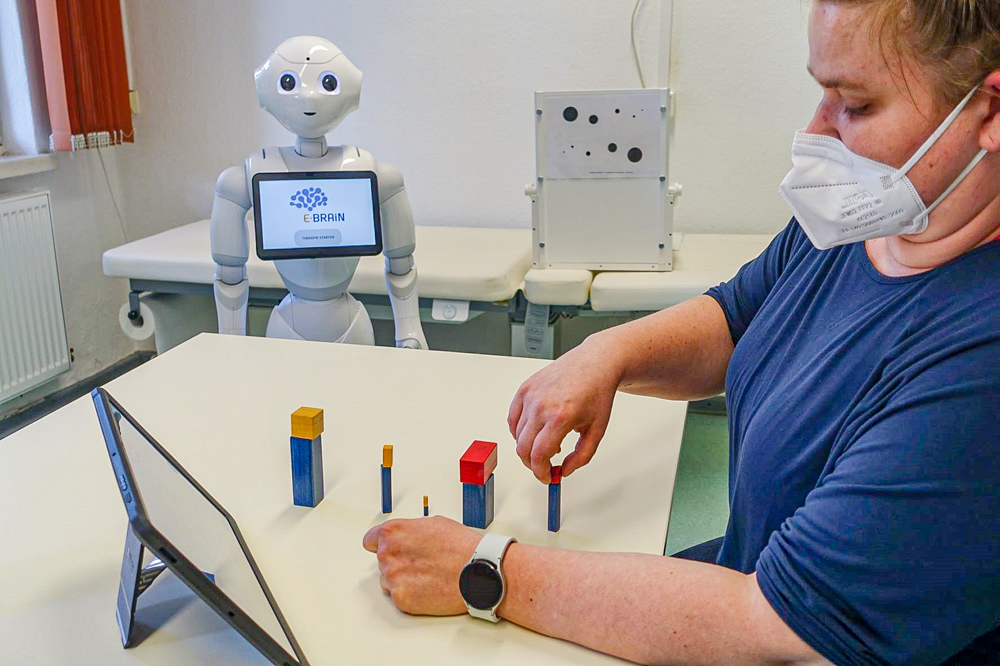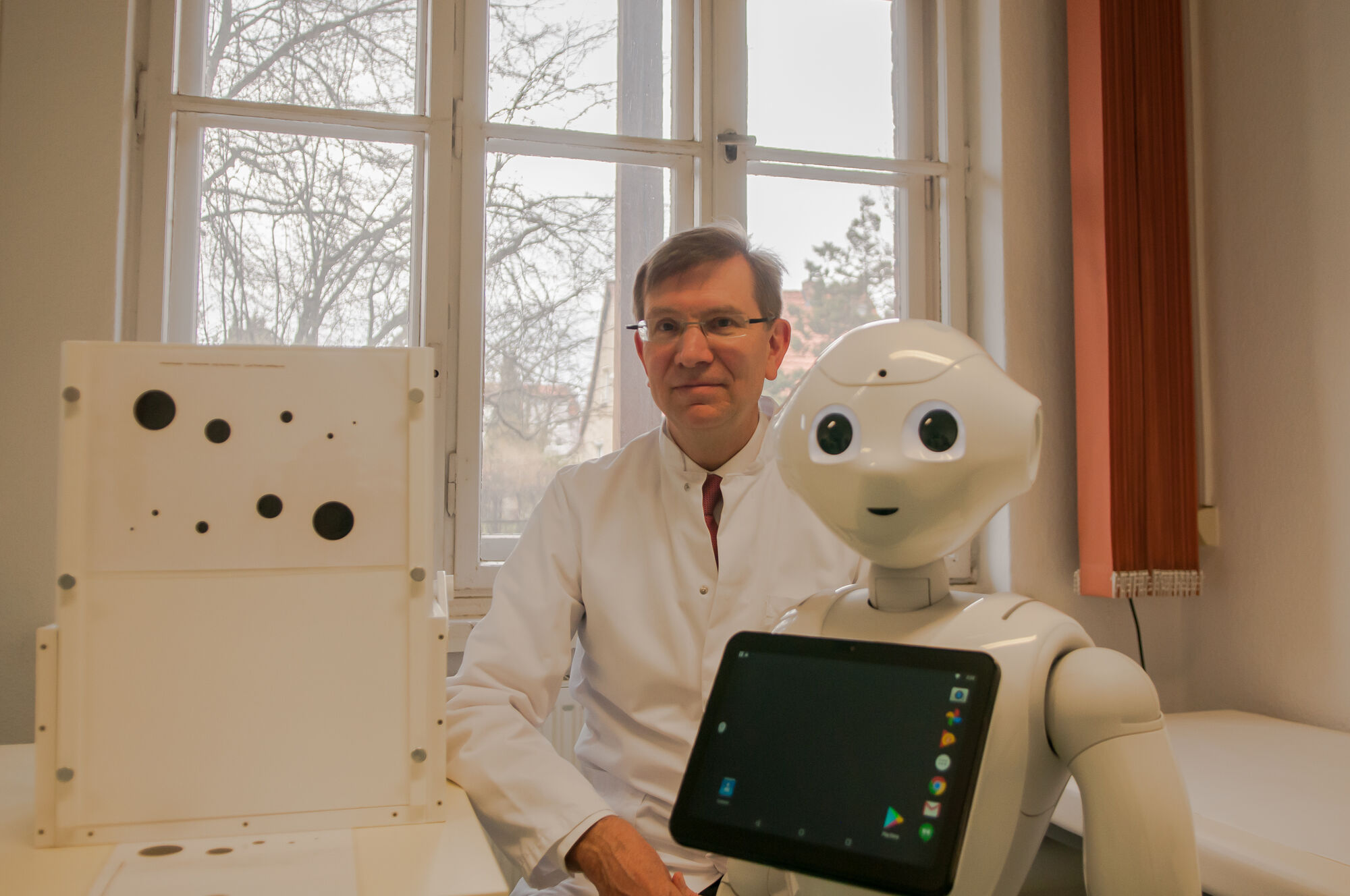Scientists from University Medicine Greifswald and the University of Greifswald (Germany) want to improve rehabilitation following a stroke through artificial intelligence and the use of a humanoid robot. Together with researchers from the Department of Computer Science, University of Rostock, and the University of Applied Sciences in Neubrandenburg, they have been working on such a system for three years. Rehabilitative training is complicated and demanding, patients need comprehensive guidance, which the humanoid robot is able to provide thanks to artificial intelligence. Those affected also prefer the human-like shape to a straight computer application. The humanoid robot opens and closes the therapeutic session professionally, provides information about the prescribed training, how it works (four different forms of therapy are implemented), and how it will help the patients reach their individual therapeutic goal. During the training, the humanoid robot gives instructions (supported by photos and videos) and provides feedback on achievements and any progress made. It also asks whether the patients need a break or whether the stroke survivors are ready to continue. And it does all of this in a nice and friendly way, paying attention to (looking at) the patient, and using natural gestures.
When compared to training sessions with human therapists who provided the same type of arm rehabilitation exercises (Arm Basis Training, ABT, or Arm Ability Training, AAT), the “overall picture” of how the robot guided patients was remarkably similar to the guidance given by human therapists. In fact, the robot explained how the training will help a patient achieve their individual treatment goal more frequently than its human counterpart. Some differences were seen in technical limitations, e.g. the robot cannot sense the patient’s innervation pattern (ABT) or register and respond to patients’ spontaneous utterances. Importantly, patients receiving arm rehabilitation sessions guided by the humanoid robot were as focussed and engaged in these sessions as patients who were being treated by a human therapist. This was the case not only when the training commenced and everything was new and exciting, but also after two weeks of intensive daily training.
“To our knowledge, this is the first therapeutic expert system for neurorehabilitation using a humanoid robot that provides different forms of therapy in such a comprehensive and fairly autonomous way. We are currently investigating its clinical effectiveness. The published research indicates an important milestone achievement for our research: the similarity of individualised coaching provided by the humanoid robot when compared to human therapists providing the same types of arm rehabilitation is indeed reassuring,” states Prof. Dr. Thomas Platz, Head of the Neurorehabilitation Research Group at University Medicine Greifswald, (UMG) who initiated and coordinates the research. “This research is not about replacing therapists; in the future we will need more professionals. However, humanoid robots might help therapists to enable more stroke victims to train more intensively and thus support their recovery in the best possible way.”
Other researchers involved were Philipp Deutsch and Ann Louise Pedersen from the Neurorehabilitation Research Group and Alexandru-Nicolae Umlauft and Sebastian Bader from the Department of Computer Science at the University of Rostock.
This research is part of the research project “E-BRAiN - Evidence-based Robot Assistance in Neurorehabilitation” that was funded by the European Social Fund (ESF), reference: ESF/14-BM-A55-0001/19-A04, and the Ministry of Education, Science and Culture of Mecklenburg-Vorpommern, Germany as part of a research excellency programme.
Source:
Platz T, Pedersen AL, Deutsch P, Umlauft A-N and Bader S (2023) Analysis of the therapeutic interaction provided by a humanoid robot serving stroke survivors as a therapeutic assistant for arm rehabilitation. Front. Robot. AI 10:1103017. doi: 10.3389/frobt.2023.1103017
Further information:
AG Neurorehabilitation
E-BRAiN
About the first photo:
The photo illustrates the therapeutic scenarios for the digital therapeutic system E-BRAiN using a humanoid robot to provide therapeutic interaction during arm rehabilitation sessions for a stroke survivor. Note, in this scenario for the Arm Ability Training for mild arm paresis, the patient is able to train the (mildly) affected right arm themself; here, the robot provides all therapeutic interaction (provision of information, feedback, bond-related interaction) while the patient is led through a sequence of training tasks. The supervising staff in the background is only monitoring the situation and ready to step in if there was an error in the system designed to run autonomously, or the patient required help that could not be provided by the system.
For media purposes, the photo can be downloaded and used free of charge, acknowledging its author at: https://cloud.med.uni-greifswald.de/index.php/s/cd7c7ick19yfrqw (Passwort: ROBOT)
cloud.med.uni-greifswald.de/index.php/s/cd7c7ick19yfrqw
Contact at the University of Greifswald
Prof. Dr. med. Thomas Platz
Neurorehabilitation Research Group, University Medicine Greifswald &
Institute for Neurorehabilitation and Evidence-Based Practice (affiliated institute), BDH-Klinik Greifswald
Fleischmannstrasse 44
D-17475 Greifswald
Tel: +49 3834 871 490
Fax: +49 3834 871 302
Thomas.Platzuni-greifswaldde
ResearchGate: https://www.researchgate.net/profile/Thomas-Platz-2


